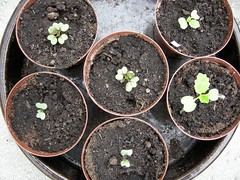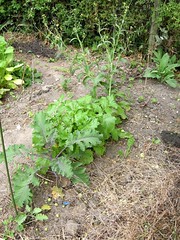|
|
Post by johno on Jan 11, 2009 11:06:41 GMT -5
Just wondered... if anybody has ever crossed ornamental cabbage with 'regular' cabbage to get a more eye-appealing edible for market?
|
|
|
|
Post by houseodessey on Jan 11, 2009 12:00:09 GMT -5
Aren't most ornamental cabbages actually kale? If so, would they cross with cabbage? I think it's a great idea to experiment with.
|
|
|
|
Post by canadamike on Jan 11, 2009 12:02:20 GMT -5
all cabbages crosss my dear, the're all oleacera...
|
|
|
|
Post by houseodessey on Jan 11, 2009 12:15:35 GMT -5
Somehow, I knew you'd clear that up for me.  |
|
|
|
Post by ottawagardener on Jan 11, 2009 12:29:20 GMT -5
If it's kale that you are trying to cross, some are B. oleracera (European) - ex. Lancinato - and some are B. napus (Ruso-siberian) - ex. red russian. Sometimes, these are misnamed as Brassica oleracera (or maybe this is more complicated than I understand?) I am not sure if all ornamental kales are B. oleracera though, they might be?
However, my understanding is that there are ornamental kale and cabbage! I presume the ornamental cabbage would be B. oleracera.
Sounds like fun!
|
|
|
|
Post by canadamike on Jan 11, 2009 14:09:35 GMT -5
Nope, you're right, the words ''russian kale'' is a mixed bag of both. I know about one that is not an Oleracea, but there might be a few others B. Oleacera around named russian too, who knows ...
|
|
|
|
Post by Alan on Jan 16, 2009 16:55:54 GMT -5
I believe Ken Ettlinger over at Long Island Seed Project crossed some ornamental Kales into one of his Kale mixes but I am not entirely certain, if your interested go over to www.liseed.org and look through his ramblings or seed lists until you find Kale. |
|
|
|
Post by ottawagardener on Jan 16, 2009 18:15:30 GMT -5
I love the rambling section but I think this is what you were talking about. Not sure if flowering kales were in the background or just highly ruffled types like 'Redbor' which is best described, I understand, as an ornamental.
"This is a mixture of kales from around the world that have ruffled and smooth leaves, tall and compact plants, many colors and growth forms including some that are considered so beautiful as to be considered ornamental. All edible and particularly so, after frost. There may be a minor amount of decorative leafy collards in here as well. A traditional winter meal of boiled kale and potatoes turns into a feast when the leftovers are chopped and spiced up a bit, then fried up in a butter/olive oil blend like one would prepare hash browns. (60 seeds) "
|
|
|
|
Post by toad on Feb 20, 2009 18:01:08 GMT -5
If it's kale that you are trying to cross, some are B. oleracera (European) - ex. Lancinato - and some are B. napus (Ruso-siberian) - ex. red russian. B. napus originates in cross(es) between B.oleracera and B.rapa. You better take a look at en.wikipedia.org/wiki/Triangle_of_U rather than having me confuse anybody  I had some fun last year with some seeds I was presented. They originated from a selfpollinated red kale, grown from seeds of swede. From the very beginning I could tell there were three different types of seedlings.  www.flickr.com/photos/10348212@N07/3295416467/sizes/l/ www.flickr.com/photos/10348212@N07/3295416467/sizes/l/ for a larger photo Later they grew up to become two kales (one very dwarf and one reddish), two turnips (white rooted) and two mustard greens (red tinged leaves).  www.flickr.com/photos/10348212@N07/3295417263/sizes/l/ www.flickr.com/photos/10348212@N07/3295417263/sizes/l/ for a larger photo I find it interesting, that already before first normal leaves, I could sort the plants, giving a possiblity to powerbreed on this kind of mixed up genes. You could also do a color sorting, seeding more than needed, and then growing the seedling with the desired colours. I know a lady who make her own cabbage seeds for 20+ years. She grow a line of mixed white and red cabbage. By colorsorting the seedlings, she can grow both white, red and shades between. She keep her line by always taking seeds from both white and red, along with some of those in between. |
|
|
|
Post by atimberline on Feb 20, 2009 23:53:25 GMT -5
Just wondered... if anybody has ever crossed ornamental cabbage with 'regular' cabbage to get a more eye-appealing edible for market? ...all the ornamental kales and cab's are B. oleracea. ...and I am sure that they have been used in crosses somewhere... I made a lot of crosses between them and brussel sprouts to get some powerful winterhardy color... used ornamental kales in crosses with broc. and cauliflowers, ...kohlrabi... Gai Lohn (to get more sweetness)... Russian kales... Tim Peters |
|
|
|
Post by raymondo on Feb 24, 2009 0:29:31 GMT -5
They originated from a selfpollinated red kale, grown from seeds of swede. I'm a bit confused here. Of course, I'm easily confused these days! Did someone grow some swedes that turned out to be red kale? Or was it seed from a swede plant that had been crossed up? (I'm assuming swede here means rutabaga.) |
|
|
|
Post by canadamike on Feb 24, 2009 20:00:01 GMT -5
I think he meant crossed up...
|
|
|
|
Post by toad on Mar 7, 2009 14:32:28 GMT -5
OK, I managed to spread confusion here :-)
The swede (rutabaga) seeds was bought in UK from a seedcompany. Swedes are Brassica napus, and among the swedes grew a red kale, seemingly a B. napus kale. It could originate in a accidential cross in the field growing the original swede seeds, but I don't know.
My point was, that you have a chance to sort the seedling for color and some other characteristics, thus you can increse the speed of breeding, to get some pretty brassicas.
|
|